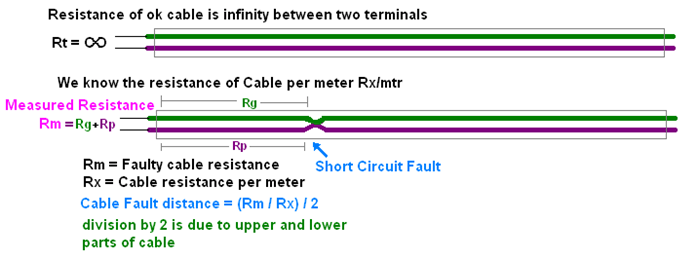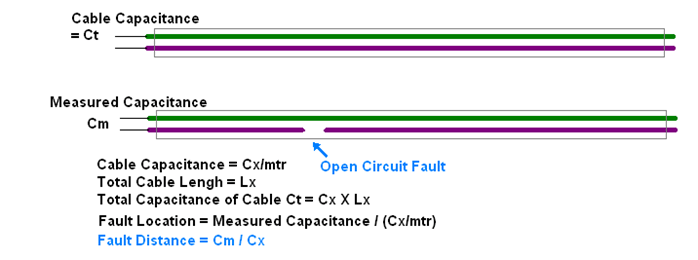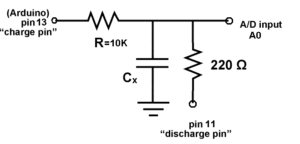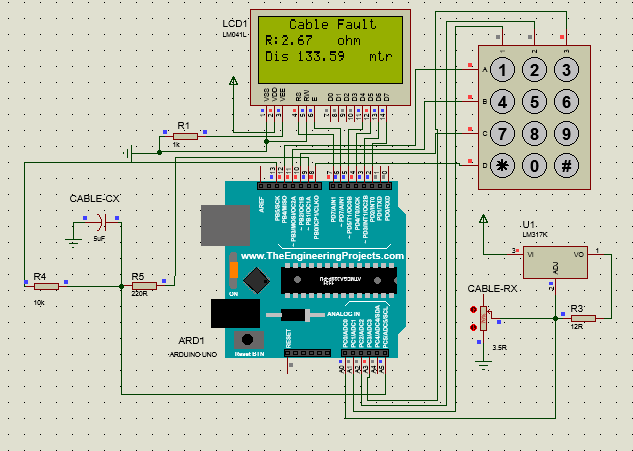Introduction
The objective of this project is to determine the distance of underground cable fault from base station in kilometers using an Arduino board. The underground cabling system is a common practice followed in many urban areas. There are many electrical, telephone and other signal cables are laid underground.
Many time faults occur due to construction works and other reasons. At that time it is difficult to dig out cable due to not knowing the exact location of the cable fault.
Definition
Capacitance is defined as the ability of a body to store an electric charge. The SI unit of capacitance is the farad (symbol: F), named after the English physicist Michael Faraday. A 1 farad capacitor, when charged with 1 coulomb of electrical charge, has a potential difference of 1 volt between its plates.
Many time faults occur due to construction works and other reasons. At that time it is difficult to dig out cable due to not knowing the exact location of the cable fault.
Definition
Capacitance is defined as the ability of a body to store an electric charge. The SI unit of capacitance is the farad (symbol: F), named after the English physicist Michael Faraday. A 1 farad capacitor, when charged with 1 coulomb of electrical charge, has a potential difference of 1 volt between its plates.
working principle
working principle
Capacitance Measurement
Each Arduino capacitance meter relies on the same basic property of capacitors- the time constant. The time constant of a capacitor is defined as the time it takes for the voltage across the capacitor to reach 63.2% of its voltage when fully charged. Larger capacitors take longer to charge, and therefore have larger time constants. An Arduino can measure capacitance because the time a capacitor takes to charge is directly related to its capacitance by the equation:
TC = R x C
TC is the time constant of the capacitor (in seconds).
R is the resistance of the circuit (in Ohms).
C is the capacitance of the capacitor (in Farads).
What we learn?
1. What are the different cable faults?
2. How to detect cable faults?
3. How to detect fault location?
4. How to measure small value resistance?
Different Cable Fault
There are main two faults in cable short circuit and open circuit.
1-short Circuit Fault

Short circuit can be determined by measuring resistance between two cables at one end (base station). The value of resistance tells us the exact location of short circuit.
2-Open Circuit Fault

Open Circuit can be detected by measuring the capacitance between two wires. Capacitance of cable changes according to the length. The length of cable varies based on the location of cable cut (open). As the cable is open parallel wire capacitance gets reduced based on this we can calculate the fault location.
Cable Open Circuit Fault
The proposed system is to find the exact location of the fault. The project uses the standard concept of Ohms low i.e when a DC voltage is applied at the feeder end through a Cable lines, then current would vary depending upon the location of fault in the cable. In case there is a short circuit (Line to Ground), the voltage across series resistors changes accordingly, which is then fed to inbuilt ADC of Arduino board to develop precise digital data for display in kilometers.
The project is assembled with a set of resistors representing cable length in KM’s and fault creation is made by a set of switches at every known KM to cross check the accuracy of the same. The fault occurring at a particular distance and the respective phase is displayed on a LCD interfaced to the Arduino board. Further this project enhanced by measuring capacitance of cable which can even locate the open circuited cable
Arduino Based Underground Cable Fault Detection and Capacitance Measurement using Arduino.
The circuit is consists of 4 line display,
1 Arduino
2 Keypad
3 Resistance measurement circuit
4 Capacitance Measurement Circuit.
Short Circuit Fault:
Main component of the underground cable fault detection circuit is low value resistance measurement. It is constructed using a constant current source of 100mAmps. It can measure very low value resistance as the cables have around 0.01 Ohm/meter resistance. For 10meter cable resistance becomes 0.1 Ohm.This circuit can measure resistance up 50 Ohm, Maximum cable length it can check up to 2500 meters.
Open Circuit Fault:

Algorithm for capacitance measurement code
Each Arduino capacitance meter relies on the same basic property of capacitors- the time constant. The time constant of a capacitor is defined as the time it takes for the voltage across the capacitor to reach 63.2% of its voltage when fully charged. Larger capacitors take longer to charge, and therefore have larger time constants. An Arduino can measure capacitance because the time a capacitor takes to charge is directly related to its capacitance by the equation:
TC = R x C
TC is the time constant of the capacitor (in seconds).
R is the resistance of the circuit (in Ohms).
C is the capacitance of the capacitor (in Farads).
What we learn?
1. What are the different cable faults?
2. How to detect cable faults?
3. How to detect fault location?
4. How to measure small value resistance?
Different Cable Fault
There are main two faults in cable short circuit and open circuit.
1-short Circuit Fault

Short circuit can be determined by measuring resistance between two cables at one end (base station). The value of resistance tells us the exact location of short circuit.
2-Open Circuit Fault

Open Circuit can be detected by measuring the capacitance between two wires. Capacitance of cable changes according to the length. The length of cable varies based on the location of cable cut (open). As the cable is open parallel wire capacitance gets reduced based on this we can calculate the fault location.
Cable Open Circuit Fault
The proposed system is to find the exact location of the fault. The project uses the standard concept of Ohms low i.e when a DC voltage is applied at the feeder end through a Cable lines, then current would vary depending upon the location of fault in the cable. In case there is a short circuit (Line to Ground), the voltage across series resistors changes accordingly, which is then fed to inbuilt ADC of Arduino board to develop precise digital data for display in kilometers.
The project is assembled with a set of resistors representing cable length in KM’s and fault creation is made by a set of switches at every known KM to cross check the accuracy of the same. The fault occurring at a particular distance and the respective phase is displayed on a LCD interfaced to the Arduino board. Further this project enhanced by measuring capacitance of cable which can even locate the open circuited cable
Arduino Based Underground Cable Fault Detection and Capacitance Measurement using Arduino.
The circuit is consists of 4 line display,
1 Arduino
2 Keypad
3 Resistance measurement circuit
4 Capacitance Measurement Circuit.
Short Circuit Fault:
Main component of the underground cable fault detection circuit is low value resistance measurement. It is constructed using a constant current source of 100mAmps. It can measure very low value resistance as the cables have around 0.01 Ohm/meter resistance. For 10meter cable resistance becomes 0.1 Ohm.This circuit can measure resistance up 50 Ohm, Maximum cable length it can check up to 2500 meters.
Open Circuit Fault:

Algorithm for capacitance measurement code
- Set discharge pin to INPUT (so it can’t discharge the capacitor)
- Set charge pin to OUTPUT and make it HIGH
- Record the start time with millis()
- Check the voltage repeatedly in a loop until it gets to 63.2% of total voltage.
- After the cap is charged, subtract the current time from the start time
- Divide the Time in seconds by the charging Resistance in ohms to find the Capacitance.
- Report the value with print on Serial monitor.
- Discharge the capacitor. To do this:
- Set the charge pin to Input
- Set the discharge pin to OUTPUT and make it LOW
- Read the voltage to make sure the capacitor is fully discharged
- Loop and do it again
circuit
 Underground Cable Fault Detection Circuit
Underground Cable Fault Detection CircuitArduino code
Team
Husam Y. AL-Hetari
SUPERVISOR eng :



